Abstract
Storage conditions and duration have a considerable influence on wine quality. Optimum temperature and humidity conditions may improve wine quality through ageing, while incorrect or excessively long storage leads to negative results. In order to evaluate the global effects of storage on red wine composition, 20 Sangiovese wines were stored in two different conditions (cellar or house) for a period of 2 years and analysed every 6 months. Untargeted LC–MS analysis showed various putative markers for the type and length of conservation (i.e. pigments, flavanols, pantothenic acid etc.), while targeted LC–MS confirmed and expanded these results within specific metabolic groups. The results of multivariate analysis showed that wines stored in the cellar changed little even after 2 years of storage, while wines stored in typical domestic conditions (house) developed approximately four times faster, reaching a composition similar to wines stored in the cellar for 2 years after just 6 months. The formation of several monosulfonated flavanols during domestic ageing provided the first evidence in wine of a reaction between wine tannins—both catechins and proanthocyanidins—and the exogenous antioxidant bisulfite. Moreover, ageing in domestic conditions appeared to induce an accelerated decrease in wine pigments, while specifically promoting the formation of pinotin A-like pigments and the hydrolysis of flavonol glycosides.






Similar content being viewed by others
References
Arapitsas, P., Perenzoni, D., Nicolini, G., & Mattivi, F. (2012a). Study of Sangiovese wines pigment profile by UHPLC-MS/MS. Journal of Agricultural and Food Chemistry, 60(42), 10461–10471.
Arapitsas, P., Scholz, M., Vrhovsek, U., et al. (2012b). A metabolomic approach to the study of wine micro-oxygenation. PLoS One, 7(5), e37783.
Bae, Y. (1989). Douglas-fir inner bark procyanidins: Sulfonation, isolation and characterization. Oregon State University PhD Thesis. http://ir.library.oregonstate.edu/xmlui/handle/1957/18120?show=full.
Burin, V. M., Costa, L. L. F., Rosier, J. P., & Bordignon-Luiz, M. T. (2011). Cabernet Sauvignon wines from two different clones, characterization and evolution during bottle ageing. LWT: Food Science and Technology, 44(9), 1931–1938.
Cejudo-Bastante, M. J., Hermosín-Gutiérrez, I., & Pérez-Coello, M. S. (2013). Accelerated aging against conventional storage: Effects on the volatile composition of chardonnay white wines. Journal of Food Science, 78(4), C507–C513.
Cheynier, V. (2012). Phenolic compounds: From plants to foods. Phytochemistry Reviews, 11(2–3), 153–177.
Cliff, M. A., King, M. C., & Schlosser, J. (2007). Anthocyanin, phenolic composition, colour measurement and sensory analysis of BC commercial red wines. Food Research International, 40(1), 92–100.
Cuadros-Inostroza, A., Giavalisco, P., Hummel, J., Eckardt, A., Willmitzer, L., & Peña-Cortés, H. (2010). Discrimination of wine attributes by metabolome analysis. Analytical Chemistry, 82(9), 3573–3580.
Figueiredo-González, M., Cancho-Grande, B., & Simal-Gándara, J. (2013). Garnacha Tintorera-based sweet wines: Chromatic properties and global phenolic composition by means of UV–Vis spectrophotometry. Food Chemistry, 140(1–2), 217–224.
Foo, L. Y., McGraw, G. W., & Hemingway, R. W. (1983). Condensed tannins: Preferential substitution at the interflavanoid bond by sulfite ion. Journal of Chemical Society, Chemical Communications, 672–673.
Fresco, P., Borges, F., Diniz, C., & Marques, M. P. M. (2006). New insights on the anticancer properties of dietary polyphenols. Medicinal Research Reviews, 26(6), 747–766.
Fulcrand, H., Mané, C., Preys, S., et al. (2008). Direct mass spectrometry approaches to characterize polyphenol composition of complex samples. Phytochemistry, 69(18), 3131–3138.
Ghidossi, R., Poupot, C., Thibon, C., et al. (2012). The influence of packaging on wine conservation. Food Control, 23(2), 302–311.
González Marco, A., & Ancín Azpilicueta, C. (2006). Amine concentrations in wine stored in bottles at different temperatures. Food Chemistry, 99(4), 680–685.
Gougeon, R. D., Lucio, M., Frommberger, M., et al. (2009). The chemodiversity of wines can reveal a metabologeography expression of cooperage oak wood. Proceedings of the National Academy of Sciences of the USA, 106(23), 9174–9179.
Håkansson, A. E., Pardon, K., Hayasaka, Y., De Sa, M., & Herderich, M. (2003). Structures and colour properties of new red wine pigments. Tetrahedron Letters, 44(26), 4887–4891.
Haug, K., Salek, R. M., Conesa, P., et al. (2013). MetaboLights: An open-access general-purpose repository for metabolomics studies and associated meta-data. Nucleic Acids Research, 41(Database issue), D781–D786. doi:10.1093/nar/gks1004.
Hernanz, D., Gallo, V., Recamales, Á. F., Meléndez-Martínez, A. J., González-Miret, M. L., & Heredia, F. J. (2009). Effect of storage on the phenolic content, volatile composition and colour of white wines from the varieties Zalema and Colombard. Food Chemistry, 113(2), 530–537.
Hopfer, H., Ebeler, S. E., & Heymann, H. (2012). The combined effects of storage temperature and packaging type on the sensory and chemical properties of chardonnay. Journal of Agricultural and Food Chemistry, 60(43), 10743–10754.
Kallithraka, S., Salacha, M. I., & Tzourou, I. (2009). Changes in phenolic composition and antioxidant activity of white wine during bottle storage: Accelerated browning test versus bottle storage. Food Chemistry, 113(2), 500–505.
Kwiatkowski, M. J., Skouroumounis, G. K., Lattey, K. A., & Waters, E. J. (2007). The impact of closures, including screw cap with three different headspace volumes, on the composition, colour and sensory properties of a Cabernet Sauvignon wine during two years’ storage. Australian Journal of Grape and Wine Research, 13(2), 81–94.
Landete, J. M., Ferrer, S., Polo, L., & Pardo, I. (2005). Biogenic amines in wines from three Spanish regions. Journal of Agricultural and Food Chemistry, 53(4), 1119–1124.
Laurie, V. F., Zúñiga, M. C., Carrasco-Sánchez, V., et al. (2012). Reactivity of 3-sulfanyl-1-hexanol and catechol-containing phenolics in vitro. Food Chemistry, 131(4), 1510–1516.
Leopoldini, M., Rondinelli, F., Russo, N., & Toscano, M. (2010). Pyranoanthocyanins: A theoretical investigation on their antioxidant activity. Journal of Agricultural and Food Chemistry, 58(15), 8862–8871.
Loscos, N., Hernández-Orte, P., Cacho, J., & Ferreira, V. (2010). Evolution of the aroma composition of wines supplemented with grape flavour precursors from different varietals during accelerated wine ageing. Food Chemistry, 120(1), 205–216.
Makhotkina, O., & Kilmartin, P. A. (2012). Hydrolysis and formation of volatile esters in New Zealand Sauvignon Blanc wine. Food Chemistry, 135(2), 486–493.
Makhotkina, O., Pineau, B., & Kilmartin, P. A. (2012). Effect of storage temperature on the chemical composition and sensory profile of Sauvignon Blanc wines. Australian Journal of Grape and Wine Research, 18(1), 91–99.
Mateus, N., Oliveira, J., Santos-Buelga, C., Silva, A. M. S., & De Freitas, V. (2004). NMR structure characterization of a new vinylpyranoanthocyanin–catechin pigment (a portisin). Tetrahedron Letters, 45(17), 3455–3457.
Maury, C., Clark, A. C., & Scollary, G. R. (2010). Determination of the impact of bottle colour and phenolic concentration on pigment development in white wine stored under external conditions. Analytica Chimica Acta, 660(1–2), 81–86.
Monagas, M., Bartolomé, B., & Gomez-Cordovés, C. (2005). Evolution of polyphenols in red wines from Vitis vinifera L. during aging in the bottle. European Food Research and Technology, 220(3–4), 331–340.
Nassiri-Asl, M., & Hosseinzadeh, H. (2009). Review of the pharmacological effects of Vitis vinifera (grape) and its bioactive compounds. Phytotherapy Research, 23(9), 1197–1204.
Patti, G. J., Tautenhahn, R., & Siuzdak, G. (2012). Meta-analysis of untargeted metabolomic data from multiple profiling experiments. Nature Protocols, 7(3), 508–516.
Sanchez-Ilarduya, M. B., Sanchez-Fernandez, C., Viloria-Bernal, M., et al. (2012). Mass spectrometry fragmentation pattern of coloured flavanol–anthocyanin and anthocyanin–flavanol derivatives in aged red wines of Rioja. Australian Journal of Grape and Wine Research, 18(2), 203–214.
Saucier, C. (2010). How do wine polyphenols evolve during wine ageing? Cerevisia, 35(1), 11–15.
Shahaf, N., Franceschi, P., Arapitsas, P., et al. (2013). Constructing a mass measurement error surface to improve automatic annotations in liquid chromatography/mass spectrometry based metabolomics. Rapid Communications in Mass Spectrometry, 27(21), 2425–2431.
Sun, B., Neves, A. C., Fernandes, T. A., et al. (2011). Evolution of phenolic composition of red wine during vinification and storage and its contribution to wine sensory properties and antioxidant activity. Journal of Agricultural and Food Chemistry, 59(12), 6550–6557.
Tautenhahn, R., Böttcher, C., & Neumann, S. (2008). Highly sensitive feature detection for high resolution LC/MS. BMC Bioinformatics, 9, 504.
Tautenhahn, R., Patti, G. J., Kalisiak, E., et al. (2010). metaXCMS: Second-order analysis of untargeted metabolomics data. Analytical Chemistry, 83(3), 696–700.
Theodoridis, G., Gika, H., Franceschi, P., et al. (2012). LC–MS based global metabolite profiling of grapes: Solvent extraction protocol optimization. Metabolomics, 8(2), 175–185.
Ugliano, M. (2013). Oxygen contribution to wine aroma evolution during bottle aging. Journal of Agricultural and Food Chemistry, 61(26), 6125–6136.
Villamor, R. R., Harbertson, J. F., & Ross, C. F. (2009). Influence of tannin concentration, storage temperature, and time on chemical and sensory properties of cabernet sauvignon and merlot wines. American Journal of Enology and Viticulture, 60(4), 442–449.
Vrhovsek, U., Masuero, D., Gasperotti, M., et al. (2012). A versatile targeted metabolomics method for the rapid quantification of multiple classes of phenolics in fruits and beverages. Journal of Agricultural and Food Chemistry, 60(36), 8831–8840.
Wang, J. (2012). Natural compounds as anticancer agents: Experimental evidence. World Journal of Experimental Medicine, 2(3), 45.
Wirth, J., Caillé, S., Souquet, J. M., et al. (2012). Impact of post-bottling oxygen exposure on the sensory characteristics and phenolic composition of Grenache rosé wines. Food Chemistry, 132(4), 1861–1871.
Wirth, J., Morel-Salmi, C., Souquet, J. M., et al. (2010). The impact of oxygen exposure before and after bottling on the polyphenolic composition of red wines. Food Chemistry, 123(1), 107–116.
Acknowledgments
The authors thank the Consortium di Montalcino for providing the grapes, Tomas Roman for small scale winemaking, Mario Malacarne for basic oenological analysis, Pietro Franceschi for his useful comments and the winery of the Fondazione Edmund Mach for the cellar storage experiment. To the project: QUALIFU – Qualità alimentare e funzionale, D.M. 2087/7303/09 of 28/01/2009, for financial support.
Conflict of interest
The authors have no conflict of interest to declare in submitting this manuscript.
Author information
Authors and Affiliations
Corresponding author
Electronic supplementary material
Below is the link to the electronic supplementary material.
Rights and permissions
About this article
Cite this article
Arapitsas, P., Speri, G., Angeli, A. et al. The influence of storage on the “chemical age” of red wines. Metabolomics 10, 816–832 (2014). https://doi.org/10.1007/s11306-014-0638-x
Received:
Accepted:
Published:
Issue Date:
DOI: https://doi.org/10.1007/s11306-014-0638-x




